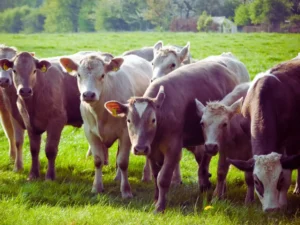Summary
The U.S. Department of Agriculture’s APHIS has introduced a new rule requiring electronic identification (EID) tags for certain cattle and bison. These RFID tags improve traceability from birth to slaughter and help reduce livestock disease outbreaks. The rule will take effect 180 days after its publication in the Federal Register, advancing livestock management modernization.

Advancements in RFID Tagging for Livestock
APHIS’s new regulations focus on strengthening traceability in the livestock industry by mandating RFID-equipped EID tags. These tags will track sexually intact cattle and bison over 18 months old, dairy cattle, and animals used in rodeos or recreational events. Consequently, the system will rapidly trace cattle during disease outbreaks, ensuring swift identification and containment efforts.
Key Benefits of RFID in Cattle Tagging
RFID tagging significantly reduces the manual processes of traditional animal identification, which relies on visually reading printed numbers on metal tags. Manual data entry increases transcription errors, disrupts herd management, and heightens stress for animals and handlers. In contrast, RFID technology minimizes these disruptions and offers several benefits:
- Faster Data Collection: RFID tags enable veterinarians and producers to gather animal data efficiently.
- Accurate Records: RFID minimizes errors in manual data entry, leading to more reliable tracking.
- Less Stress on Herds: Since RFID data can be collected without extensive handling, the risk of injury to livestock and handlers is reduced.
The Scale of RFID Implementation
The USDA estimates that the U.S. cattle and bison population fluctuates between 85 million and 100 million animals annually. With the new mandate, millions of cattle within the designated age and use categories will need RFID-enabled EID tags. These tags will feature both visual ID components and electronic RFID chips, aiding in the animal’s identification throughout its lifetime.
Producers who already tagged their livestock with visual-only ID tags before the new regulations took effect do not need to re-tag their livestock with RFID tags. However, all future cattle within the specified categories must have visual and electronic identifiers.
LF and UHF RFID Technologies in Use
The approved RFID tags for this regulation include low-frequency (LF) 134.2 kHz RFID tags compliant with ISO 11784 and 11785 standards, as well as ultra-high-frequency (UHF) RFID tags. Since 2020, APHIS has provided up to 8 million LF RFID button tags annually to state animal health officials for use in monitoring cattle and bison across the states.
APHIS does not endorse specific tag providers but allows companies to submit RFID products encoded with a 15-digit official ID number (starting with the U.S. country code “840”) for approval. The agency maintains a list of approved providers, ensuring that all tags meet stringent standards for effective identification.

Frequently Asked Questions
- Why is the USDA implementing RFID tagging regulations now?
The USDA aims to enhance livestock traceability to quickly and efficiently manage disease outbreaks. By mandating RFID tags, the agency seeks to modernize cattle identification systems and provide better tracking capabilities.
- Which animals are affected by the new regulation?
The rule applies to sexually intact cattle and bison over 18 months of age, all dairy cattle, and animals used in rodeo or recreation events.
- Do producers need to re-tag cattle that have already been identified with visual-only tags?
No, cattle that already had official visual identification-only tags before the new rules came into effect will not need to be re-tagged with RFID-enable tags.
- What types of RFID tags are approved by APHIS?
The approved RFID tags include low-frequency (LF) 134.2 kHz RFID tags compliant with ISO standards and ultra-high-frequency (UHF) RFID tags.
- How does RFID technology benefit livestock management?
RFID tags provide faster and more accurate data collection. They reduce errors in manual record-keeping and lower stress on animals and handlers by minimizing handling.
Comparison of RFID and Traditional Cattle Identification Methods
| Identification Method | Data Collection Process | Error Rate | Impact on Herd Management | Speed of Processing |
| Traditional Metal Tags | Visual reading, manual entry | High | Disruptive | Slower |
| RFID EID Tags | Automated scanning with RFID | Low | Minimal | Faster |
This table shows the advantages of RFID technology over metal tags, explaining why the USDA’s shift to electronic identification benefits the livestock industry. The new regulations will bring long-term benefits to cattle producers, veterinarians, and the agricultural community.
